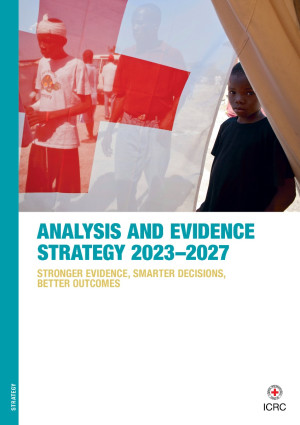Building Bridges: ICRC’s Journey Towards a Centralized Analysis and Evidence Unit
At the close of 2021, the International Committee for the Red Cross (ICRC) embarked on a journey to establish a central Analysis and Evidence (A&E) unit aimed at meeting the multidisciplinary evidence needs of the entire organization’s programs and operational units. Prior to this organization-wide endeavor, the ICRC’s Economic Security Unit (EcoSec) had already demonstrated success with its own A&E unit, dedicated to generating and effectually utilizing evidence to provide lifesaving services and support the livelihoods of communities impacted by conflict. Building on this foundation, alongside the impetus provided by the Outcome-Based Approach (OBA) initiative and accomplishments of the Evidence-Based Protection (EBP) team, the ICRC laid out plans for a 6-year A&E unit and strategy.
Additionally, organic A&E initiatives emerging from field-level programs in Yemen, Myanmar, Iraq, and Colombia underscored the necessity for a centralized A&E unit. These initiatives were born out of their respective local humanitarian response evidence needs and highlighted a gap in the effective allocation of organizational resources. Across the board, there was a prevalent need for a technical support mechanism that would exceed the sum of independent thematic evidence units that could help harmonize language, definitions, measurement, and understanding throughout program cycles. Centralizing ICRC’s evidence and analysis streams, however, does not reinforce a hierarchy, rather, it integrates pre-existing capacities and discovers entryways to enhance these siloed capacities through collaboration.
Moreover, the organization-wide A&E initiative achieved an institutional key priority from the Outcomes-Based Approach initiative, strengthening the use of evidence in decision-making and improving program quality control. In 2022, ICRC released the 6-year strategic plan for their newly established Analysis and Evidence unit, housed within the Department of Protection and Essential Services (P&ES), with their four core strategic priorities being:
- Strengthening evidence-based and outcome-oriented decision-making.
- Enabling multidisciplinary, needs-based, and people-centric programs.
- Promoting a culture of learning.
- Leveraging human and social capital in Analysis and Evidence.
The A&E Unit’s strategic priorities align with the organizational cultural shifts needed to achieve common humanitarian protection outcomes across traditionally siloed issue areas that ICRC works on. War and conflict increase communities’ exposure to violence, deliberate deprivation, and coercion, and this manifests in deprivation from education, food, medical services and people’s livelihoods. Across the humanitarian community, these issue areas are addressed through a sectoral approach, neglecting the interlinked nature of varying protection risks for civilians living conflict. ICRC’s generation and utilization of multi-sectoral and multidisciplinary evidence produced in close coordination with frontline staff and affected communities is one step closer to achieving an overarching vision of shared outcomes across all conflict-related issue areas.
Meaningful humanitarian outcomes can only be achieved through continuous and reiterative contextual analysis within a humanitarian circumstance. For the A&E unit’s strategic priority number one, this translates to decision-making that is based on consistent situation monitoring, geospatial analysis, predictive analytics, and early warning tools conducive to well-informed swift and critical decision-making regarding people’s humanitarian needs. Ultimately, this priority is defined by establishing an information management system within ICRC with several working parts that are working towards continuously collecting and analyzing information.
ICRC’s strategic priorities for the A&E unit embody an organizational culture shift that will enable traditionally siloed sectors to understand the intersections of their work. Strategic priority two stresses the criticality of multidisciplinary people-centric programs in deciphering the dynamics between individuals, their communities, and households through direct engagement and feedback from local communities. Humanitarian needs, as emphasized in the strategy, are multidisciplinary, so conducting multidisciplinary needs assessments with the participation of various sectoral actors will be instrumental in producing holistic protection outcomes. The A&E unit will work towards developing multisectoral referral mechanisms and tools that will aid ICRC field workers in reaching populations in need of protection and essential services, who otherwise would not be reached through a non-integrated evidence and analysis.
The A&E puts organizational learning, behavior, and attitude change at the forefront of program quality and maintaining accountability toward humanitarian aid benefits. This priority deals with undoing stigmas around organizational failures and identifying better methods to circulate lessons learned from program evaluations. This will ensure that program evaluation is done through a learning-oriented method rather than a reporting-oriented method.
With the A&E unit in its final planning phase in 2023, it is exciting to witness ICRC rolling out an organizational cultural change through strategic internal coordination and collaboration. The A&E unit will compromise ICRC staff from different technical backgrounds and regional offices, allowing the organization to tap into untouched sources of knowledge and advance a culture of learning and adaptation. This process undertaken by ICRC is a strong example of demonstrating the importance for the humanitarian community to adopt a similar learning-oriented approach to data collection and analysis. The process demonstrates how internal components within an organization’s systems can be brought together to produce better quality, measurable outcomes across all the humanitarian issues an organization works to address.
